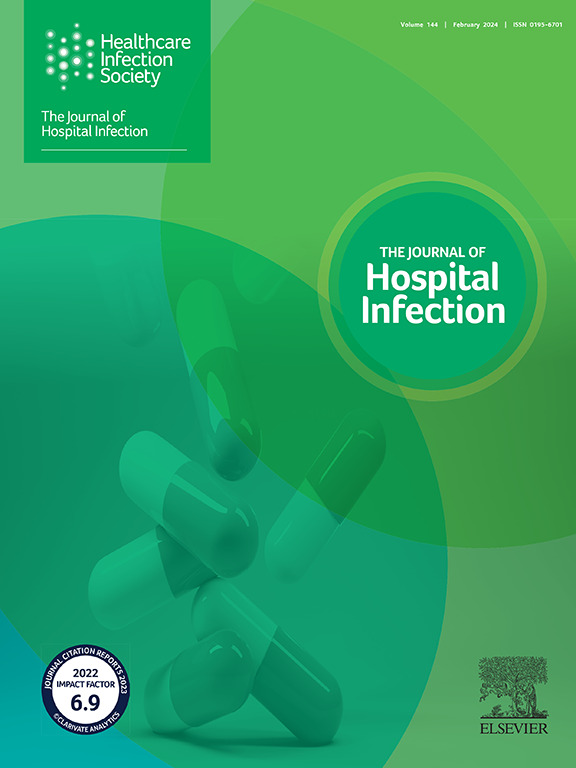Impact of ultraviolet light disinfection on reducing hospital-associated infections: a systematic review in healthcare environments
IF 3.9
3区 医学
Q1 INFECTIOUS DISEASES
引用次数: 0
Abstract
Background
Hospital-associated infections (HAIs) are a significant burden on healthcare systems. Ultraviolet light (UVL) disinfection has emerged as a potential method for reducing HAIs by decontaminating healthcare environments.
Aim
To evaluate the effectiveness of UVL in reducing HAIs across various hospital settings.
Methods
A systematic literature review was conducted following the Preferred Reporting Items for Systematic Reviews and Meta-Analyses guidelines, with searches performed in PubMed, Web of Science, and Scopus through July 2023. Peer-reviewed observational and experimental studies assessing UVL's impact on HAIs were included. Data extraction focused on study characteristics, UVL type, and infection outcomes. Studies focusing on environmental contamination or lacking sufficient data were excluded.
Findings
Twenty-five studies met the inclusion criteria. UVL types included ultraviolet-C (UV-C), pulsed xenon UV (PX-UV), and unspecified UVL. For PX-UV, several studies reported reductions in infection rates, with some showing up to a 70% decrease in Clostridioides difficile infection rates, especially in high-risk areas such as intensive care units, though results vary across settings, with some studies not observing significant improvements. UV-C disinfection has also been found to reduce HAIs, with its effectiveness varying based on the healthcare setting and targeted pathogens, and it is most effective when used in conjunction with other infection control strategies.
Conclusion
UVL disinfection technologies have demonstrated potential in reducing HAIs, particularly when integrated into a comprehensive infection prevention strategy. Their effectiveness, however, varies by application, pathogen type, and healthcare setting. Further research is needed to optimize UVL implementation and assess its cost-effectiveness in diverse clinical environments.
紫外线消毒对减少医院相关感染的影响:卫生保健环境的系统综述
背景:医院相关性感染(HAIs)是医疗保健系统的重大负担,需要有效的预防策略。紫外线(UVL)消毒已成为一种通过净化医疗环境来减少HAIs的潜在方法。目的:本系统综述评估UVL在不同医院环境下减少HAIs的有效性。方法:根据系统评价和荟萃分析指南的首选报告项目进行系统文献综述,并在PubMed, Web of Science和Scopus中进行检索,直至2023年7月。包括同行评议的观察性和实验性研究,评估紫外线照射对HAIs的影响。数据提取侧重于研究特征、UVL类型和感染结果。侧重于环境污染或缺乏足够数据的研究被排除在外。结果:25项研究符合纳入标准。紫外线类型包括紫外- c (UV- c),脉冲氙紫外线(PX-UV)和未指定的紫外线。对于PX-UV,几项研究报告了感染率的降低,有些研究显示艰难梭菌感染率降低了70%,特别是在重症监护病房等高风险区域,尽管结果因环境而异,有些研究没有观察到显着的改善。研究还发现,UV-C消毒可以减少HAIs,其效果因卫生保健环境和目标病原体而异,与其他感染控制策略结合使用时效果最佳。结论:紫外线消毒技术已显示出减少HAIs的潜力,特别是当与综合感染预防战略相结合时。然而,它们的有效性因应用、病原体类型和医疗保健环境而异。需要进一步的研究来优化UVL的实施,并评估其在不同临床环境中的成本效益。
本文章由计算机程序翻译,如有差异,请以英文原文为准。
求助全文
约1分钟内获得全文
求助全文
来源期刊

Journal of Hospital Infection
医学-传染病学
CiteScore
12.70
自引率
5.80%
发文量
271
审稿时长
19 days
期刊介绍:
The Journal of Hospital Infection is the editorially independent scientific publication of the Healthcare Infection Society. The aim of the Journal is to publish high quality research and information relating to infection prevention and control that is relevant to an international audience.
The Journal welcomes submissions that relate to all aspects of infection prevention and control in healthcare settings. This includes submissions that:
provide new insight into the epidemiology, surveillance, or prevention and control of healthcare-associated infections and antimicrobial resistance in healthcare settings;
provide new insight into cleaning, disinfection and decontamination;
provide new insight into the design of healthcare premises;
describe novel aspects of outbreaks of infection;
throw light on techniques for effective antimicrobial stewardship;
describe novel techniques (laboratory-based or point of care) for the detection of infection or antimicrobial resistance in the healthcare setting, particularly if these can be used to facilitate infection prevention and control;
improve understanding of the motivations of safe healthcare behaviour, or describe techniques for achieving behavioural and cultural change;
improve understanding of the use of IT systems in infection surveillance and prevention and control.
 求助内容:
求助内容: 应助结果提醒方式:
应助结果提醒方式:


